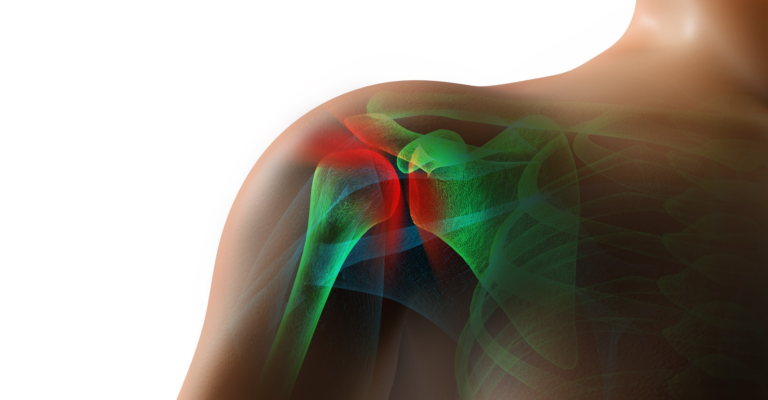
Are You Experiencing A Rotator Cuff Tear?
If you have, or are, you’ll know that simple activities like brushing your hair or your teeth, tying your shoes, and sleeping can become painful reminders of your injury.
What is a Rotator Cuff?
 Your Rotator Cuff is a group of muscles and tendons that are located in the shoulder and the upper back area. They connect the upper arm to the shoulder blade. The tendons of the rotator cuff provide stability to the shoulder area, with the muscles allowing the shoulders to rotate. This network of muscles that come together as tendons that cover the head of the humerus (the bone in your upper arm that attaches to your shoulder) is called the rotator cuff. This is where the mobility of your entire shoulder originates, so you can imagine how debilitating it could be when it causes pain. The level of inflammation caused by this injury can dictate how much pain is experienced.
Your Rotator Cuff is a group of muscles and tendons that are located in the shoulder and the upper back area. They connect the upper arm to the shoulder blade. The tendons of the rotator cuff provide stability to the shoulder area, with the muscles allowing the shoulders to rotate. This network of muscles that come together as tendons that cover the head of the humerus (the bone in your upper arm that attaches to your shoulder) is called the rotator cuff. This is where the mobility of your entire shoulder originates, so you can imagine how debilitating it could be when it causes pain. The level of inflammation caused by this injury can dictate how much pain is experienced.
What Are The Symptoms?
Some symptoms include pain at night, especially if you are trying to sleep on the affected shoulder. Pain when lowering or raising your arm to perform a movement. Weakness and pain when lifting your arm, and a grating sound or sensation made when there is friction between the bones and cartilage.
5 Common Causes of a Rotator Cuff Tear
- Overuse, especially when playing overhead sports like tennis or vollyball.
- Improper form when weightlifting, or lifting weights overhead. Particularly if there is poor core stability.
- Hypermobile (double jointed) shoulders or loose connective tissue.
- A traumatic injury like falling with an arm extended out, or being pushed from behind.
- Poor posture and rolling forward of the shoulders will pull on the entire rotator cuff.
How A Chiropractor Can Help
We will evaluate the injury as there could be many possible causes. We’ve even seen old hip injuries that have affected the opposite rotator cuff. We are aware that rotator cuff tears can happen from shoulder instability, but we also know that shoulder instability and weakness go hand in hand with core weakness and old injuries.
Treatment Options
There are several different treatment approaches, each being specific to your injury, amount of pain, and your level of fitness. Strength is a very important component to rehab and long term care. Ensuring there is optimal core stability, along with strength development in the upper body is key to reducing further injuries. Ultimately, in severe cases surgery is required, our goal is to ensure we take very possible action to prevent this as a last resort.
The Ultimate Goal
Our ultimate goal is to help you avoid surgery. Surgery comes with its own set of risks; it will require you to take time away from your work, your life, and your family. In addition, the pain medications prescribed post surgery run the risk of side effects and addiction. Rotator cuff tears can be quite painful in the beginning, and the healing process takes time. Don’t prolong this process with guesswork, or waiting it out. The potential to stunt healing can only make matters worse. If you are experiencing a rotator cuff tear, contact us today to discuss treatment options.
How to Create a More Ergonomic Workspace at Home
As the world experiences many long term changes, you may have found yourself “working from home” a lot longer than expected. For some, this change has been a welcomed addition to how we work. For others, this has been quite challenging because of family roles, and for some the only real challenge has been ergonomics.
You Don’t Want to Develop Postural Issues
 Now that many are working from home for the foreseeable future, working on your laptop from the couch isn’t going to be a viable option. Postural issues are the biggest concern as people tend to hunch over their computer or laptop when at home. So how can you ensure ergonomics work in your favour? The following is a list of some things to keep in mind when setting up your ergonomic workspace in your home. Invest in a straight backed chair. Working from the couch, or even worse – your bed, is the worst position you can be in. These positions will always cause your head to hunch forward, affecting your neck, shoulders and your upper spine. Aside from having a straight backed chair, doing neck stretches and exercises throughout the day to prevent tightness is ideal. Keep your laptop at eye level to keep your shoulders upright and your neck straight. If you are looking down you will be causing your shoulders to roll forward and your neck to hunch over. Again, taking breaks to stretch or exercise your neck and roll your shoulders will be helpful to prevent strains and headaches. Keep your arms at 90 degrees, ensuring your elbows are bent comfortably while your hands reach for the keyboard. Having the keyboard too high can create tingling in your hands and arms, and too low can cause you to hunch forward. The key here is to keep moving, getting up at least once an hour will allow your body to prevent stiffness and postural issues. Have your feet planted flat on the ground. Having your feet dangling will not only cause some swelling in your feet, but it can really affect the arch in your back. With your feet flat on the floor, the over arch won’t happen, and your body will feel more stable.
Now that many are working from home for the foreseeable future, working on your laptop from the couch isn’t going to be a viable option. Postural issues are the biggest concern as people tend to hunch over their computer or laptop when at home. So how can you ensure ergonomics work in your favour? The following is a list of some things to keep in mind when setting up your ergonomic workspace in your home. Invest in a straight backed chair. Working from the couch, or even worse – your bed, is the worst position you can be in. These positions will always cause your head to hunch forward, affecting your neck, shoulders and your upper spine. Aside from having a straight backed chair, doing neck stretches and exercises throughout the day to prevent tightness is ideal. Keep your laptop at eye level to keep your shoulders upright and your neck straight. If you are looking down you will be causing your shoulders to roll forward and your neck to hunch over. Again, taking breaks to stretch or exercise your neck and roll your shoulders will be helpful to prevent strains and headaches. Keep your arms at 90 degrees, ensuring your elbows are bent comfortably while your hands reach for the keyboard. Having the keyboard too high can create tingling in your hands and arms, and too low can cause you to hunch forward. The key here is to keep moving, getting up at least once an hour will allow your body to prevent stiffness and postural issues. Have your feet planted flat on the ground. Having your feet dangling will not only cause some swelling in your feet, but it can really affect the arch in your back. With your feet flat on the floor, the over arch won’t happen, and your body will feel more stable.
We Need to Keep Moving
As it stands, our bodies were not created to sit for extended periods of time. Much like being at the office, it’s recommended that you get up at least once an hour to stretch, use the washroom, grab a glass of water or a snack, or to just do a lap around the room. Now that working from home has become a longer term situation, it’s so important to not only create a schedule for your workday, but the ergonomics that go into completing your work are vitally important.
The New Normal
The combination of Zoom meetings, phone calls, emails, and paperwork can have you spending endless hours sitting. You must get up and move, and you must have a schedule for yourself to prevent overworking – or the opposite, underworking.
Make it Pleasing and Personal
Aside from ergonomics, ensure your workspace is pleasant and in a well lit area of your home. Have items on your desk that you enjoy, have your favourite mug ready for your workday, include a picture on your desk, have music playing – all the things that bring you joy on a regular day at work. You may be missing your coworkers, or just the social aspect of being at the office, but If you haven’t created a way to make work enjoyable at home this could turn out to be a very long handful of winter months. This may not be how you’re used to working, it may not be how you want to work; but making the best of what we have will make a world of difference both physically and emotionally.
